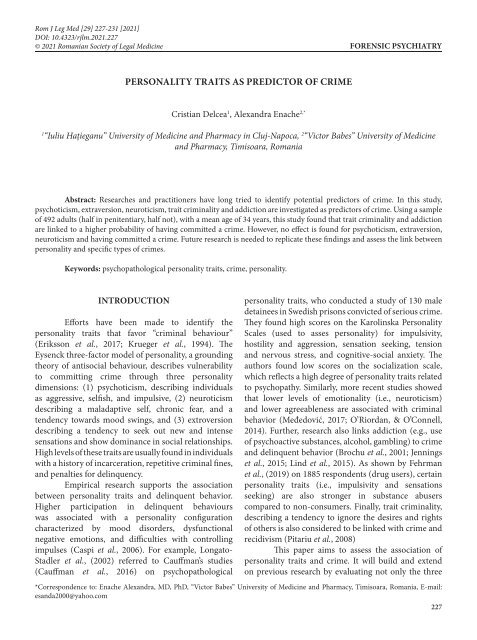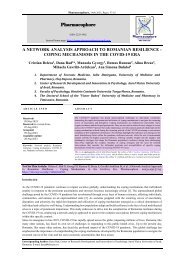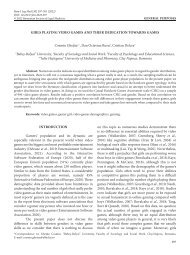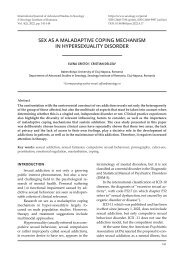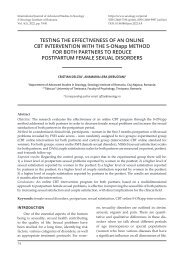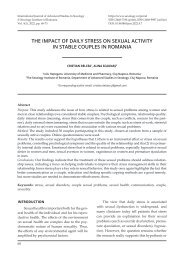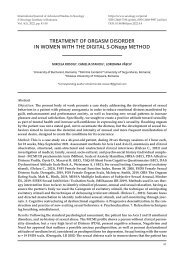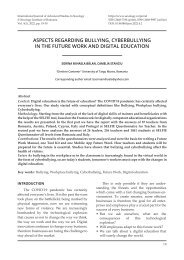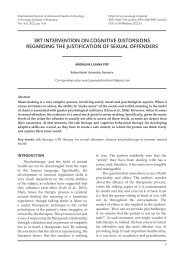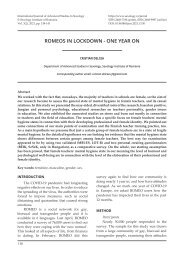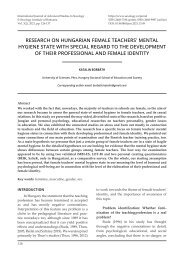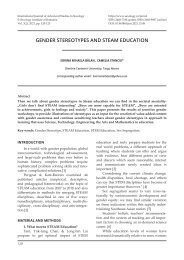PERSONALITY TRAITS AS PREDICTOR OF CRIME
Researches and practitioners have long tried to identiy potential predictors o crime. In this study,psychoticism, extraversion, neuroticism, trait criminality and addiction are investigated as predictors o crime. Using a sampleo 492 adults (hal in penitentiary, hal not), with a mean age o 34 years, this study ound that trait criminality and addictionare linked to a higher probability o having committed a crime. However, no effect is ound or psychoticism, extraversion,neuroticism and having committed a crime. Future research is needed to replicate these findings and assess the link betweenpersonality and specific types o crimes.
Researches and practitioners have long tried to identiy potential predictors o crime. In this study,psychoticism, extraversion, neuroticism, trait criminality and addiction are investigated as predictors o crime. Using a sampleo 492 adults (hal in penitentiary, hal not), with a mean age o 34 years, this study ound that trait criminality and addictionare linked to a higher probability o having committed a crime. However, no effect is ound or psychoticism, extraversion,neuroticism and having committed a crime. Future research is needed to replicate these findings and assess the link betweenpersonality and specific types o crimes.
- No tags were found...
You also want an ePaper? Increase the reach of your titles
YUMPU automatically turns print PDFs into web optimized ePapers that Google loves.
Rom J Leg Med [29] 227-231 [2021]<br />
DOI: 10.4323/rjlm.2021.227<br />
© 2021 Romanian Society of Legal Medicine<br />
FORENSIC PSYCHIATRY<br />
<strong>PERSONALITY</strong> <strong>TRAITS</strong> <strong>AS</strong> <strong>PREDICTOR</strong> <strong>OF</strong> <strong>CRIME</strong><br />
Cristian Delcea 1 , Alexandra Enache 2,*<br />
1<br />
“Iuliu Hațieganu” University of Medicine and Pharmacy in Cluj-Napoca, 2 “Victor Babes” University of Medicine<br />
and Pharmacy, Timisoara, Romania<br />
Abstract: Researches and practitioners have long tried to identify potential predictors of crime. In this study,<br />
psychoticism, extraversion, neuroticism, trait criminality and addiction are investigated as predictors of crime. Using a sample<br />
of 492 adults (half in penitentiary, half not), with a mean age of 34 years, this study found that trait criminality and addiction<br />
are linked to a higher probability of having committed a crime. However, no effect is found for psychoticism, extraversion,<br />
neuroticism and having committed a crime. Future research is needed to replicate these findings and assess the link between<br />
personality and specific types of crimes.<br />
Keywords: psychopathological personality traits, crime, personality.<br />
INTRODUCTION<br />
Efforts have been made to identify the<br />
personality traits that favor “criminal behaviour”<br />
(Eriksson et al., 2017; Krueger et al., 1994). The<br />
Eysenck three-factor model of personality, a grounding<br />
theory of antisocial behaviour, describes vulnerability<br />
to committing crime through three personality<br />
dimensions: (1) psychoticism, describing individuals<br />
as aggressive, selfish, and impulsive, (2) neuroticism<br />
describing a maladaptive self, chronic fear, and a<br />
tendency towards mood swings, and (3) extroversion<br />
describing a tendency to seek out new and intense<br />
sensations and show dominance in social relationships.<br />
High levels of these traits are usually found in individuals<br />
with a history of incarceration, repetitive criminal fines,<br />
and penalties for delinquency.<br />
Empirical research supports the association<br />
between personality traits and delinquent behavior.<br />
Higher participation in delinquent behaviours<br />
was associated with a personality configuration<br />
characterized by mood disorders, dysfunctional<br />
negative emotions, and difficulties with controlling<br />
impulses (Caspi et al., 2006). For example, Longato-<br />
Stadler et al., (2002) referred to Cauffman’s studies<br />
(Cauffman et al., 2016) on psychopathological<br />
personality traits, who conducted a study of 130 male<br />
detainees in Swedish prisons convicted of serious crime.<br />
They found high scores on the Karolinska Personality<br />
Scales (used to asses personality) for impulsivity,<br />
hostility and aggression, sensation seeking, tension<br />
and nervous stress, and cognitive-social anxiety. The<br />
authors found low scores on the socialization scale,<br />
which reflects a high degree of personality traits related<br />
to psychopathy. Similarly, more recent studies showed<br />
that lower levels of emotionality (i.e., neuroticism)<br />
and lower agreeableness are associated with criminal<br />
behavior (Međedović, 2017; O’Riordan, & O’Connell,<br />
2014). Further, research also links addiction (e.g., use<br />
of psychoactive substances, alcohol, gambling) to crime<br />
and delinquent behavior (Brochu et al., 2001; Jennings<br />
et al., 2015; Lind et al., 2015). As shown by Fehrman<br />
et al., (2019) on 1885 respondents (drug users), certain<br />
personality traits (i.e., impulsivity and sensations<br />
seeking) are also stronger in substance abusers<br />
compared to non-consumers. Finally, trait criminality,<br />
describing a tendency to ignore the desires and rights<br />
of others is also considered to be linked with crime and<br />
recidivism (Pitariu et al., 2008)<br />
This paper aims to assess the association of<br />
personality traits and crime. It will build and extend<br />
on previous research by evaluating not only the three<br />
*Correspondence to: Enache Alexandra, MD, PhD, “Victor Babes” University of Medicine and Pharmacy, Timisoara, Romania, E-mail:<br />
esanda2000@yahoo.com<br />
227
C. Delcea and A. Enache<br />
personality dimensions described by Eysenck, but also<br />
two other important psychopathological characteristics:<br />
addiction and criminality. Further, a large sample is<br />
used, including both participants convicted for crime,<br />
and participants that did not commit crime (as selfreported).<br />
Given past research and Eysenck three-factor<br />
model of personality, it is expected that: Psychoticism,<br />
extraversion, neuroticism, criminality and addiction<br />
will emerge as predictors of crime, such that high scores<br />
on these personality dimensions will be associated with<br />
a higher probability of having committed crime.<br />
METHODS<br />
Sample and Procedure<br />
For this study, a convenience sample was<br />
used. Data collection took place in 2018, between the<br />
month of March to December. An initial group of 400<br />
of detainees from Romanian penitentiary were asked<br />
to participate in research requiring the completion of<br />
a set of questionnaires. To be eligible to participate,<br />
they had to be aged 18 or older, to have committed<br />
the crime of aggravated murder and to have followed<br />
at least eight years of education. Additionally, a<br />
number of 399 adults (older than 18 years of age),<br />
were approached to also complete the questionnaires.<br />
They were workers, students in professional schools<br />
and university students. They did not have a history of<br />
murder or other associated crimes (as self-reported).<br />
An equal proportion of males to females was desired in<br />
both groups (participants recruited from penitentiary<br />
and from universities). The inclusion and exclusion<br />
criteria lead to a total number of 492 participants<br />
included in the analysis (50% males, Mage = 34.14;<br />
SDage=10.66; Meducation=11.28; SDeducation =2.01).<br />
From these, 246 adults have committed crime, and 246<br />
had no history of crime. Compared to those outside<br />
penitentiary, participants that have committed crime<br />
were older t (488.88) = -6.936, p < .001, d = .62 (30.95<br />
vs 37.32 years), and less educated t(478.44) = 3.910, p <<br />
.001, d = .35 (11.63 vs. 10.93).<br />
Eligible participants for this study signed<br />
a consent form for their participation in the study.<br />
The recruitment procedure was according to the<br />
standards imposed by Romanian law: The National<br />
Agency of Penitentiaries of Romania (ANP) approved<br />
conducting research in the institutions. Throughout the<br />
completion of The Eysenck Personality Questionnaire-<br />
Revised-EPQ-R for the assessment of personality traits,<br />
respondents received the support and information<br />
necessary for the proper conduct of the assessment. A<br />
pen-and pencil form of the EPQ-R was used. The raw<br />
results were entered manually in the software program of<br />
each EPQ-R questionnaire, and after the computerized<br />
interpretation and profiling, from the software program<br />
of the test, the T scores were evaluated. The scores were<br />
than introduces in the SPSS database.<br />
ME<strong>AS</strong>URES<br />
Personality<br />
The Eysenck Personality Questionnaire-<br />
Revised-EPQ-R (Eysenck S. B. G., Eysenck H. J.,<br />
1991), revised version and adapted on the Romanian<br />
population was used (Pitariu et al., 2008). The scale<br />
measures the following psychopathological dimensions<br />
of personality: psychoticism, neuroticism, extroversion,<br />
lie, addiction and criminality. The EPQ-R questionnaire<br />
is used in the psychiatric and forensic clinics as well<br />
as in penitentiaries. The EPQ-R questionnaire has<br />
106 items and takes around 30 minutes to complete.<br />
The psychological profiles resulted from the test<br />
can be interpreted through the different personality<br />
dimensions, ranging from high to low scores.<br />
ANALYSIS<br />
To test the hypotheses, the program IBM SPSS<br />
Statistics for Windows, version 25 was used (IBM,<br />
2017). Prior to running the analysis, all scores were<br />
standardized. Descriptive statistics were run to get an<br />
overview of the data, providing the overall mean scores,<br />
standard deviations, and Pearson correlations between<br />
the variables. Logistic regression was performed to<br />
predict the crime. Six models were run to test the<br />
effect of each trait independently on crime, while<br />
controlling for age, gender, and education (the sixth<br />
model contained only the demographic variables as<br />
predictors, introduced simultaneously). Note that the<br />
both B-coefficients (B) and odds ratios (Exp(B)) were<br />
reported, to ease interpretation of the predictors in the<br />
models.<br />
RESULTS<br />
Table 1 shows descriptive statistics for all<br />
variables. Significant, moderate positive associations<br />
were found between psychoticism and neuroticism<br />
(r = .41, p < .01), meaning that in this sample,<br />
individuals higher on neuroticism also scored higher<br />
on psychoticism). Moderate associations were found<br />
228
Personality traits as predictor of crime<br />
between psychoticism and trait criminality (r = .46,<br />
p < .01) and between psychoticism and addiction (r<br />
= .56, p < .01). A small positive association (r = .12,<br />
p < .01) was observed between extraversion and<br />
criminality. Large significant associations were found<br />
between neuroticism and addiction (r = .71, p < .01)<br />
and neuroticism and criminality, r = .70, p < .01 (those<br />
higher on neuroticism scored higher on addiction and<br />
criminality). A small negative association (r = -.11, p<br />
< .01) was found between education and criminality<br />
(those less educated scored higher on trait criminality).<br />
With respect to the variables of main interest for<br />
this study, a negative small association was observed<br />
between having committed a crime and education<br />
(r = -.17, p < .01), such that those less educated were<br />
also those more likely to report a crime. Small positive<br />
association emerged between addiction and crime (r =<br />
.15, p < .01) and between trait criminality and crime (r<br />
= .12, p < .01), meaning that higher scores on addiction<br />
and criminality were associated with crime.<br />
As can be seen from Table 2, controlling for the<br />
other demographic predictors (age, gender, education)<br />
had a significant effect on crime, such that the lower the<br />
education the higher the probability to have committed<br />
crime (B = -.18, Exp(B) = .83, 2 (1) = 14.28 (Wald<br />
Test), p < .001, CI95 = .75; .91). Age had also an effect<br />
on crime, such that in this sample, the higher the age,<br />
the higher the probability of committed crime (B =<br />
.064, Exp(B) = 1.07, 2 (1) = 40.83 (Wald Test), p < .001,<br />
CI95 = 1.05; 1.09).<br />
With respect to personality traits, controlling for<br />
education, gender and age, psychoticism, extraversion,<br />
neuroticism and lie did not predict crime. Controlling<br />
for gender, age and education, addiction had a positive<br />
effect on crime (B = .03, Exp(B) = 1.03, 2 (1) = 9.86<br />
(Wald Test), p = .002, CI95 = 1.01; 1.05). This means<br />
that the larger the score on addiction, the larger the<br />
predicted probability that a person committed a crime<br />
(or, for every one unit increase in addiction, the odds<br />
of crime increase with 1.03). Trait criminality has also a<br />
significant effect on crime, meaning that the larger the<br />
addiction score, the larger the predicted probability that<br />
a person committed a crime (B = .015; Exp(B) = 1.02,<br />
2 (1) = 6.01 (Wald Test), p = .014, CI95 = 1.00; 1.03). In<br />
other words, for every one unit increase in criminality,<br />
the odds of having committed crime increase with 1.02.<br />
DISCUSSION<br />
The aim of this study was to investigate the<br />
predictive effect of personality on crime. It was found<br />
that addiction and trait criminality were linked to a<br />
Table 1. Descriptive statistics for variables of the study<br />
Variable M SD Age Educ. P E N L A C<br />
Age 34.14 10.66<br />
Educ. 11.28 2.01 -.02<br />
P 51.33 9.87 .01 .06<br />
E 51.47 8.91 -.06 -.01 .05<br />
N 51.92 9.70 .03 -.04 .41** .07<br />
L 57.58 11.52 .02 -.04 -.04 .03 -.08<br />
A 49.26 11.73 .04 -.04 .56** -.04 .71** -.22**<br />
C 56.54 15.76 .01 -.11* .46** .12** .70** .06 .73**<br />
Crime - - .30** -.17** .06 -.04 .07 -.04 .15** .12**<br />
* Corresponds to p
C. Delcea and A. Enache<br />
higher probability to have committed crime, which is<br />
in line with my hypothesis. However, no effect of trait<br />
psychoticism, extraversion and neuroticism on crime<br />
was found.<br />
An association between addiction and crime<br />
was previously found, with different types of addictive<br />
behaviors being linked to criminal behavior (use of<br />
psychoactive substances, alcohol, gambling; Brochu et<br />
al., 2001; Jennings et al., 2015; Lind et al., 2015). Further,<br />
the association between trait criminality and having<br />
committed a crime is to be expected, as those higher in<br />
this trait have a tendency to ignore the desires of others,<br />
while also showing symptoms of emotional instability<br />
(Pitariu et al., 2008). However, the non-finding for<br />
the PEN traits on crime is surprising given some past<br />
literature (Boduszek et al., 2013; Bourke et al., 2013; Van<br />
Dam et al., 2005). For example, Van Dam et al., (2005)<br />
have linked psychoticism and extraversion to juvenile<br />
delinquency or recidivism. Psychoticism in the direction<br />
proposed by PEN model of Eysenck (high scores on<br />
psychoticism linked to delinquency) and extraversion in<br />
the opposite direction, with the offender’s group being<br />
lower on the trait than the comparison group composed<br />
of students. Interestingly, when linking personality traits<br />
with recidivism, they found different results for official<br />
reports (police reports) and self-reports of recidivism. It<br />
could thus be that different finding for the association<br />
between personality and delinquency result depending<br />
on how the latter was assessed: self-report or objective<br />
assement. Following the similar line of thought, different<br />
findings could result on incarcerated versus nonincarcerated<br />
samples, or on specific subtype of offenders.<br />
A similar conclusion was drawn by Bourke et al., (2013),<br />
who also failed to find support for Eysenck’s theory (Popa-<br />
Nedelcu R., Delcea C., Siserman C., Carmen Domnariu<br />
D. C., 2020). More studies are thus needed to test<br />
Eysenck`s propositions, and also assess the personality<br />
– crime link, an association of high importance for<br />
clinicians and practitioners (i.e., personality change;<br />
Leal, 2017).<br />
Some limitations of this research need to be<br />
taken in account when considering these results. First,<br />
even if the present sample was balanced in terms of<br />
sex (50% female, 50% male), participants recruited<br />
from universities had followed more years of education<br />
compared to those in penitentiary (Siserman C.,<br />
Giredea C., Delcea C., 2020). However, the difference<br />
was small (with a small effect size, as defined by<br />
Cohen`s d; Cohen, 1988), with those in penitentiary<br />
having followed on average 10.39 years of education<br />
while those recruited outside penitentiary 11.63 years<br />
(Siserman C., Delcea C., Vladi Matei H., Vică L. M.,<br />
2019). It is therefore improbable that this would affect<br />
the present results. Second, this study did not distinguish<br />
between the types of crime committed. Future research<br />
is thus need to distinguish a possible differential impact<br />
of personality on specific types of crime.<br />
In conclusion, using a large sample of adults<br />
older than 18, the current study does not find support<br />
for Eysenck`s PEN model. However, this paper finds an<br />
association between trait criminality and addiction on<br />
one hand, and having committed crime on the other.<br />
More research is needed to replicate these findings.<br />
Conflict of interest<br />
The authors declare that they have no conflict of<br />
interest.<br />
References<br />
1. Boduszek D, Shevlin M, Adamson G, Hyland P. Eysenck’s<br />
personality model and criminal thinking style within a violent<br />
and nonviolent offender sample: Application of propensity score<br />
analysis. Deviant Behavior. 2013; 34(6), 483-493.<br />
2. Barlett CP, Anderson CA. Direct and indirect relations between<br />
the Big 5 personality traits and aggressive and violent behavior.<br />
Personality and individual differences. 2012; 52(8): 870-875.<br />
3. Brochu S, Cousineau MM, Gillet M, Cournoyer LG, Pernanen<br />
K, Motiuk L. Drugs, alcohol, and criminal behaviour: A profile of<br />
inmates in Canadian federal institutions. In Forum on Corrections<br />
Research. 2001; 13(3): 20-24.<br />
4. Bourke A, Boduszek D, Hyland P. The role of criminal cognitions<br />
and personality traits in non‐violent recidivism: An empirical<br />
investigation within a prison sample. Journal of Criminal<br />
Psychology. 2013; http://dx.doi.org/10.1108/20093821311307758<br />
5. Cohen J. Statistical Power Analysis for the Behavioral Sciences.<br />
New York, NY: Routledge Academic. 1988.<br />
6. Cauffman E, Cavanagh C, Donley S, Thomas A. A developmental<br />
perspective on adolescent risk-taking and criminal behavior. In A.<br />
Piquero (Ed.), Handbook of Criminological Theory. Hoboken, NJ:<br />
Wiley. 2016: 100-120.<br />
7. Eysenck HJ, Eysenck SBG. Manual of the Eysenck Personality<br />
Scales (EPS Adult): Comprising the EPQ-Revised (EPQ-R), EPQ-R<br />
Short Scale, Impulsiveness (IVE) Questionnaire... Hodder &<br />
Stoughton. 1991.<br />
8. Eriksson TG, Masche-No JG, Dåderman AM. Personality traits of<br />
prisoners as compared to general populations: Signs of adjustment<br />
to the situation? Personality and Individual Differences. 2017; 107:<br />
237-245.<br />
9. Fehrman E, Egan V, Gorban AN, Levesley J, Mirkes EM,<br />
Muhammad AK. Personality Traits and Drug Consumption: A<br />
story told by data. Springer. 2019.<br />
10. Jennings WG, Piquero AR, Rocque M, Farrington DP. The<br />
effects of binge and problem drinking on problem behavior and<br />
adjustment over the life course: Findings from the Cambridge Study<br />
in Delinquent Development. Journal of Criminal Justice. 2015;<br />
43(6), 453-463.<br />
11. Krueger RF, Schmutte PS, Caspi A, Moffitt TE, Campbell K, Silva<br />
PA. Personality traits are linked to crime among men and women:<br />
evidence from a birth cohort. Journal of abnormal psychology.<br />
1994; 103(2): 328.<br />
230
Personality traits as predictor of crime<br />
12. Leal WE. Is My Personality Your Problem? Examining the Effect<br />
of Personality on Drug Use and Criminal Involvement (Doctoral<br />
dissertation. The Florida State University). 2017.<br />
13. Lind K, Kääriäinen J, Kuoppamäki SM. From problem gambling<br />
to crime? Findings from the Finnish national police information<br />
system. Journal of Gambling Issues. 2015; 30: 98-123.<br />
14. Longato-Stadler E, Knorring LV, Hallman J. Mental and<br />
personality disorders as well as personality traits in a Swedish male<br />
criminal population. Nordic Journal of Psychiatry. 2002; 56(2): 137-<br />
144.<br />
15. Popa-Nedelcu R, Delcea C, Siserman C, Carmen Domnariu<br />
DC. The relationship between personality disorders and domestic<br />
violence in forensic context. Rom J Leg Med. 2020; 28(2)166-171.<br />
16. Riso LP, du Toit PL, Stein DJ, Young JE. Cognitive schemas and<br />
core beliefs in psychological problems: A scientist-practitioner<br />
guide (pp. xi-240). American Psychological Association. 2007.<br />
17. Međedović J. The profile of a criminal offender depicted by<br />
HEXACO personality traits. Personality and Individual Differences.<br />
2017; 107: 159-163.<br />
18. Pitariu H, Iliescu D, Baban A. Chestionarul Eysenck de<br />
Personalitate (EPQ-R). Sinapsis. 2008.<br />
19. O’Riordan C, O’Connell M. Predicting adult involvement<br />
in crime: Personality measures are significant, socio-economic<br />
measures are not. Personality and Individual Differences. 2014; 68,<br />
98-101.<br />
20. Siserman C, Giredea C, Delcea C. The Comorbidity of Paraphilic<br />
Disorders and Rape in Individuals Incarcerated for Sexual Offences.<br />
Rom J Leg Med. 2020; 28: 278-282.<br />
21. Siserman C, Delcea C, Vladi Matei H, Vică LM. Major Affective<br />
Distres in Testing Forensic Paternity. Rom J Leg Med. 2019; 27(3):<br />
292-296.<br />
22. Van Dam C, Janssens JM, De Bruyn EE. PEN, Big Five, juvenile<br />
delinquency and criminal recidivism. Personality and individual<br />
differences. 2005; 39(1): 7-19.<br />
23. Wood VF, Bell PA. Predicting interpersonal conflict resolution<br />
styles from personality characteristics. Personality and individual<br />
differences. 2008; 45(2): 126-131.<br />
231


